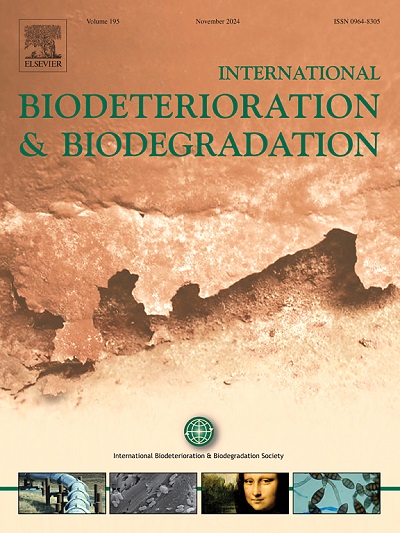Sustained protection of stone cultural relics: Utilizing antiviral oseltamivir to effectively eliminate lichen and diseases on artifacts
IF 4.1
2区 环境科学与生态学
Q2 BIOTECHNOLOGY & APPLIED MICROBIOLOGY
International Biodeterioration & Biodegradation
Pub Date : 2025-04-27
DOI:10.1016/j.ibiod.2025.106106
引用次数: 0
Abstract
Saxicolous lichens, which colonize rock substrates, play a major role in the deterioration of stone cultural relics. Traditional biocides, including antibiotics and antifungal agents, pose risks of resistance development and biofouling, underscoring the need for effective and a long-term treatment against biodeterioration. In this study, we discovered a novel double-stranded RNA (dsRNA) virus, Pyxine petricola partitivirus 1 (PpPV1), in saxicolous lichens collected from the fallen stones of the Niujiaozhai grottoes in Sichuan Province, China. This virus was found in 70.2% of saxicolous lichens from a global sample of 118 lichens, including those from notable sites, including Angkor sandstone monuments in Cambodia and the Great Wall of China. We developed a biocide strategy using the antiviral oseltamivir, which significantly reduced the viral loading and the photosynthetic activity of the lichen-forming algae, impairing lichen functionality. This innovative approach not only offers a novel method for protecting stone cultural relics but also contributes to both biocontrol and heritage conservation by safeguarding against viral pathogens and mitigating the biological damage caused by lichens.
石质文物的持续保护:利用抗病毒药物奥司他韦,有效消除文物上的地衣和疾病
石质地衣在石质文物的变质过程中起着重要的作用。传统的杀菌剂,包括抗生素和抗真菌剂,具有耐药性发展和生物污染的风险,强调需要有效和长期治疗以防止生物恶化。本研究在四川牛角寨石窟落石地衣中发现了一种新的双链RNA (dsRNA)病毒——Pyxine petricola partitivirus 1 (PpPV1)。在全球118个地衣样本中,包括来自柬埔寨吴哥砂岩纪念碑和中国长城等著名遗址的地衣样本,在70.2%的萨氏地衣中发现了该病毒。我们开发了一种使用抗病毒药物奥司他韦的杀菌剂策略,该策略显著降低了形成地衣的藻类的病毒载量和光合活性,损害了地衣的功能。这种创新的方法不仅为石质文物保护提供了一种新的方法,而且通过预防病毒病原体和减轻地衣造成的生物损害,有助于生物防治和文物保护。
本文章由计算机程序翻译,如有差异,请以英文原文为准。
求助全文
约1分钟内获得全文
求助全文
来源期刊
CiteScore
9.60
自引率
10.40%
发文量
107
审稿时长
21 days
期刊介绍:
International Biodeterioration and Biodegradation publishes original research papers and reviews on the biological causes of deterioration or degradation.

 求助内容:
求助内容: 应助结果提醒方式:
应助结果提醒方式:


